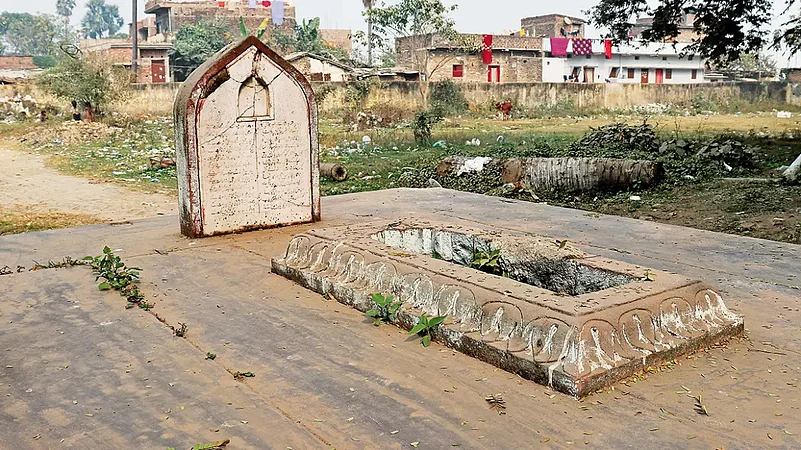Every day around dusk, a striking voice would rise up in the sky somewhere in the distance. Badi Kaneez, a famous courtesan (tawaif) and renowned singer of Azimabad—as Patna came to be known after Mughal emperor Aurangzeb’s grandson Azim-us-Shan (1664-1712) rechristened it after himself—was quite young at the time, but this would make others stop in their tracks. “As the sound grew nearer, one felt that the entire ambience was getting intoxicated by her lovely voice.
After a while, you would see a middle-aged woman in a Neemwar Fatgi (particular dress) walking slowly from Kashmiri Kothi towards my neighbourhood, the Sadar Gali. She would stop after a few steps, and then her trained voice would mesmerise onlookers as the notes burst forth,” Badi Kaneez is quoted as saying in Syed Badruddin Ahmad’s Urdu memoir Haqeeqat Bhi Kahani Bhi: Azimabad Ki Tahzibi Daastaan (1988). “Shopkeepers stopped their work and pedestrians stood where they were, to listen to her. Thus, she would pass my colony singing and walk up to Shahdara. There, the song would stop and she would disappear into the unknown,” she adds.
Azimabad, with its pulsating dance and music, was a hub of culture and arts then. And Badi Kaneez, a singer of the calibre of Zohra Bai, was a stellar figure of her time. She was much more in demand in the mehfils (concerts/parties) than Zohra Bai because she was very beautiful. She earned a massive amount of wealth because of her music and looks.
At some point, however, Badi Kaneez got addicted to alcohol. She started getting drunk round the clock. This affected her profession. As her income dropped, she started drinking country-made liquor. Soon, her addiction began to spiral out of control. In the end, she went mad. From Badi Kaneez she became the Baurahi (deranged) Kaneez. Eventually, she was in such a bad state that when she passed by singing, people who knew of her condition would hand out money on their own out of pity. But she was so proud that she never begged from anyone even in abject poverty.
In 1697, when Azim-us-Shan became the governor of Bengal, Bihar and Odisha, he wanted to turn Patna into another Delhi. He spent crores on this project. The beauty and luxury of Patna and the fame of the rich elite of the city reached faraway kingdoms of India. This led to many famous singers, musicians, courtesans and intellectuals moving to Azimabad. The splendour and pomp of this mixed city of Hindus and Muslims made it popular across India.
It is not as if courtesans were a new phenomenon in Patna. The ganikas, an old name of courtesans, have been an important part of the urban society since forever. One finds mention of many ganikas who were well-versed in dance and music in the ancient city of Patliputra. Kosha, Salvati and Chintamani were important courtesans of the Mauryan era. The royal danseuses of this era were not just dancers but held respect and an important place in the Indian society of the time. Their chariots would drive side by side with the queen during important ceremonies.
While they were the centre of attraction for connoisseurs of the performing arts, they also played the role of teachers for the children of the nobility, as they were well-educated. They had also become an important source of income for the state in those times, regularly paying taxes to the ruler.
In the Gupta era, which is called the real golden era of Indian culture, ganikas were given a prominent place. The plays of that era carry detailed descriptions of their residences, their luxurious lifestyle, their lovers, the clients who came to them, their expertise in different arts, their origins and the patronage they received from the state or the rich.

During the Mughal period, art and culture flourished under the patronage of the landlords, nobles and nawabs of Azimabad. This was an era of peace and prosperity. Azimabad was not just important politically but also a leading centre of commerce, arts and crafts. It also remained an important fulcrum of cultural activities for a long time.
British scientific explorer and surveyor Francis Buchanan, who recorded the flora, fauna and ecology of Bengal, visited Patna in the beginning of the 19th century. He describes Patna’s courtesans in his chronicles. Buchanan narrates the lives of a group of dancers-singers in Patna, consisting of 5-6 women. Two of them were Hindu, while three were Muslims. They were well-read and expert dancers and singers. Their songs were generally about love and longing. A courtesan named Mahtab was much in demand in those days. She was called to Calcutta during the Durga Puja festival. At the age of 15, she was paid Rs 1,000 for a three-night performance.
When Buchanan arrived in Patna, Mahtab was 36-years old. Even then, her fee for a night-long mujra (dance and song performance) was Rs 700, while others would charge as little as Rs 15. Patna has had a long tradition of courtesan singers, such as Badi Kaneez, Chhoti Kaneez, Mohammad Bandi, Allah Jilai Bai, Bi Ramju, Faizi, Bi Chhuttan, Chander, Munder, Gangadhari, Vidyadhari Bai, Ramdasi, Haider Jan, Tanno Bai, Faizi and Zohra Bai—all masters of their art and skills. Their programmes would often also include courtesans from Banaras, Allahabad and Agra.
Eminent courtesans included Bandi Jan ‘Naaz,’ Amir Jan ‘Ameer,’ Jiya Azeemabadi, Amirul Nisha and Sahib Jan. Zohra Bai was an acclaimed poet and a leading singer of thumris. Ramju, Bi Chhuttan and Mohammad Bandi were great artists; Bandi got her first gramophone record released in 1890.
Patna continuously attracted famous singers, musicians and courtesans of other cities. In Haqeeqat Bhi Kahani Bhi, Ahmad (1901-1983), a politician, writer and poet who also served as the general secretary of the Bihar Muslim League, captures the Ganga-Jamuni tehzeeb (culture) of Azimabad with great dexterity. In the thick volume, which runs into 578 pages and was published by the Bihar Urdu Academy, he also chronicles a number of other aspects of the city’s social fabric. “God knows what pulled beautiful personalities from other places to here: was it the allure or the appreciation of beauty in Patna’s colourful ambience?” he writes.
He writes about Allah Jilai, who had come from Allahabad and settled in Patna: “The year 1902 had just begun when an incomparable beauty arrived in Patna from Allahabad and started shining like a morning star on the colourful horizon here. Allah Jilai’s beauty was really mesmerising; many wise men lost their sanity over it. Her singing was also amazing; she was the queen of both beauty and music. She arrived and conquered Patna.”
Courtesans had set up their kothas (bordellos) in many areas on Ashok Rajpath, between Chauhatta and Patna City Chowk. Zohra Bai had a spectacular kotha in Machchharhatta, while Allah Jilai had hers at the Chowk. Ahmad writes: “The penthouse of Allah Jilai’s striking house was no less decorated than the palaces of queens and princesses. Chandeliers that held 500 candles, made of Belgian cut-glass, tapestries adorned with silver and ivory, a ceiling decorated with golden and silver flowers and leaves, massive mirrors with silver frames, flower-pots and vases made of silver, marble-tables and embroidered cloths covering them, Italian and Iranian carpets, velvet from Kashan and gold-embroidered curtains, all these valuable objects she had been gifted by the Nawab of Guzri. Sitting against the beautiful pillows in her room, Allah Jilai looked like a modern-day Cleopatra.”
Apart from being an unparalleled beauty, Allah Jilai was a brilliant thumri and dadra singer. An old connoisseur from Patna City, 90-year-old Vishwanath Shukl ‘Chanchal,’ says: “She was so fair and her skin was so soft that when she swallowed after chewing paan, one could almost see it going down her throat, as if through the glass. When this fairy sang thumri and dadra, the audience would be ready to die for her. She used to wear a sari and an embroidered cap and loved to smoke a hookah. When her hookah was filled with scented tobacco, the entire court would fill up with the perfumed smoke. All programmes in Patna were incomplete without her presence. People say that without Allah Jilai, all performances and mujras would seem colourless.”
Allah Jilai died at a very young age. She came to Patna from Allahabad at the age of 17. By 20, she became a star in Patna, and then died at 24. The city’s connoisseurs and art lovers were deeply saddened by her death.
Ahmad writes: “I was a child then, but I remember how the people of Patna were struck by her death. At the time, I was surprised why a courtesan’s death was such a major issue. Later, I understood that in that era this was a major event due to the people’s nature and culture.
Generally, the society did not look down upon admirers of beauty (those who visited courtesans).” This is true. In those days, the elite would send their children to learn etiquette from courtesans. The kothas were schools of good manners and etiquette: their particular ways of salutation, conversation, conducting oneself, welcoming, bidding adieu, etc were considered worth learning and emulating.
Allah Jilai was buried five miles away from Patna on the banks of the Ganges. In the mausoleum’s walled courtyard, facing the door, Allah Jilai’s grave stands out from the others on a high stone platform. Locals say that this memorial used to be much more beautiful. It used to be enclosed with screens and a marble candle-holder was installed towards the headrest. These items are no longer there, but a beautiful epitaph still stands.
Critic Gajendra Narayan Singh writes about Zohra Bai’s thumri in his book, Bihar Ki Sangeet Parampara (The Musical Tradition of Bihar): “Zohra Bai was a great thumri singer. She had such a great delivery that a particular note led to thumri maestro and harmonium player Bhaiya Sahab Ganpatrao asking to become her disciple, extending his wrist so that she could tie a ganda (wrist-band denoting mentorship). Her thumris would become much more alluring as she was accompanied by Ali Qadar on tabla and Bahadur Khan on sarangi.”
The first gramophone record of Mohmmad Bandi’s thumri-dadra came out in 1890. “Mohammad Bandi was not just expert in thumri and dadra but also an able singer of hori, chaiti and kajri styles. Bhairavi was her favourite raga. In those days, there were separate Bhairavi concerts, in which Mohammad Bandi was always present to impose her authority. Her delivery had a prolonged ‘kahan’ and ‘pukar’ (aspects of classical singing). In her thumri, she would especially focus on small taans, especially tappas,” writes Singh.
“Those days changed; nobility disappeared and so did courtesans!” ‘Chanchal’ laments with a sigh: “Now, there are no artists of those kind nor are the connoisseurs. Nobody even remembers now how, as dusk fell, chandeliers would light up around the chowk. The atmosphere would fill up with the scents of garlands of bela and chameli flowers, and rose and kewda perfumes. Sounds from musical instruments and anklet bells would make the entire ambience swirl. There would be a queue of decorated carriages and horse-wagons that brought the rich music fans and landlords to the area.
As the zamindari (large land-ownership) was abolished after Independence, this unique patronage of music also ended. Kothas were deserted. The courtesans were made inconsequential. Now, only their tales remain.”
(This appeared in the print edition as "The Famed Courtesans of Pataliputra")
(Views expressed are personal)
Arun Singh is a patna-based freelance journalist























